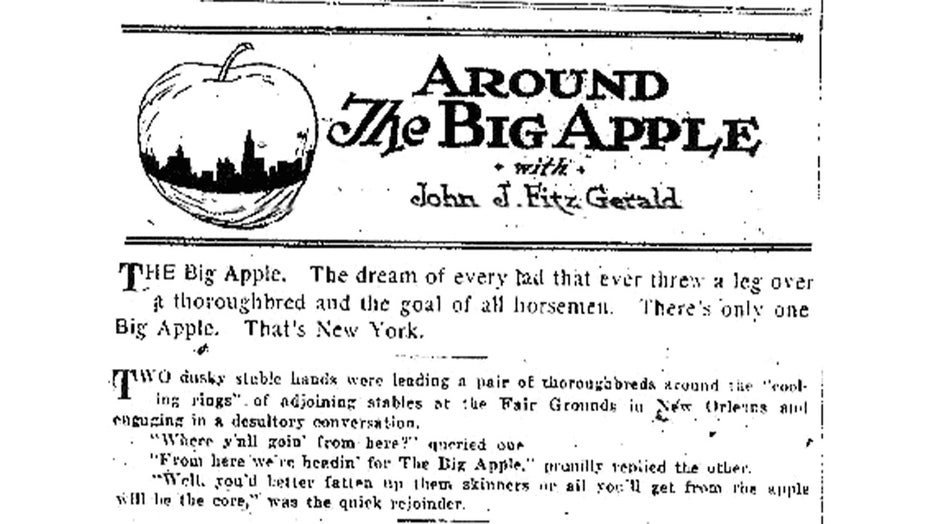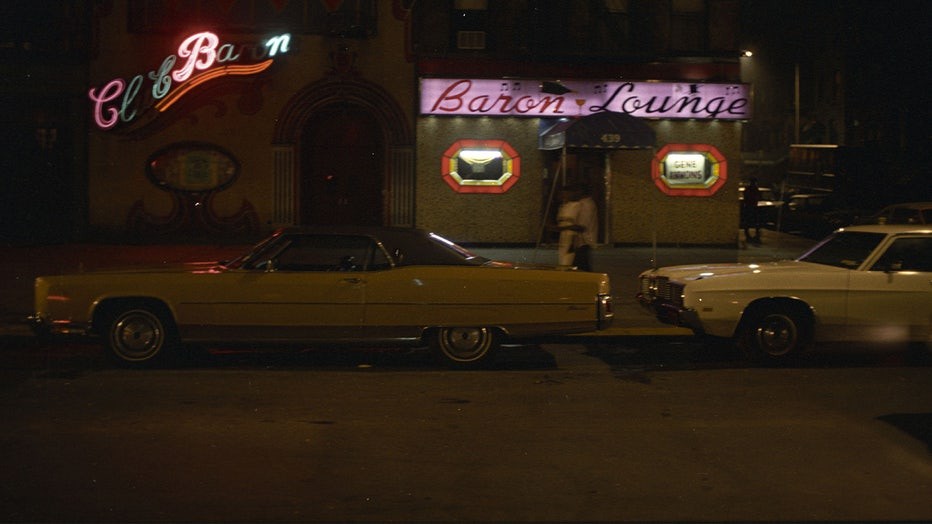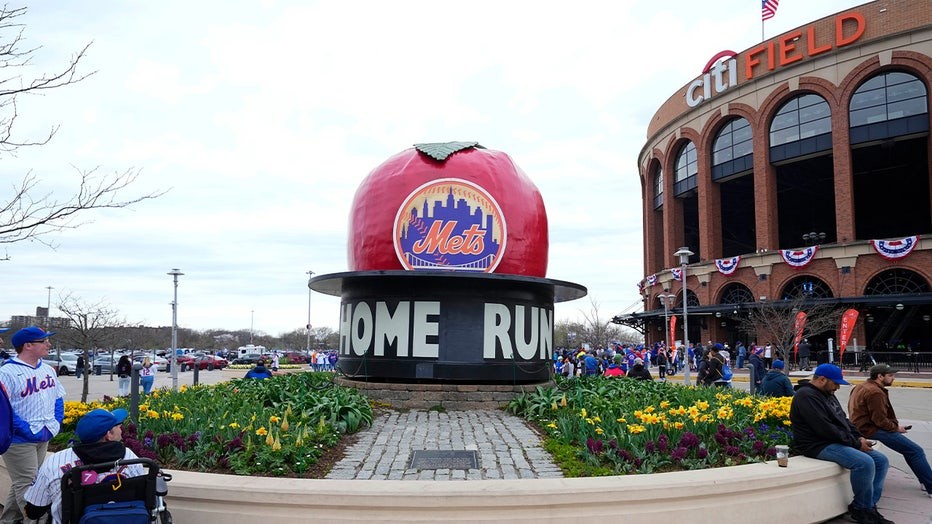Why Is Manhattan Called The Big Apple? This iconic nickname, synonymous with New York City, has a rich and fascinating history. WHY.EDU.VN explores the origins of the term, its evolution, and how it became the enduring symbol of the city that never sleeps. Discover the intriguing story behind this beloved moniker, including its roots in horse racing and its popularization through jazz music.
1. Unveiling The Mystery: The Big Apple Nickname Explained
The moniker “The Big Apple,” a famous epithet for New York City, is used worldwide. But why is Manhattan called the Big Apple? The term, popularized in the early 20th century, wasn’t always associated with tourism or city branding; its roots are far more interesting. Understanding the progression of this nickname reveals not just a linguistic quirk, but a story of ambition, aspiration, and the vibrant culture of a city.
2. From Horse Racing To City Branding: The Big Apple’s Origins
2.1. The 1920s Horse Racing Scene
The earliest documented use of “Big Apple” can be traced back to the 1920s and the world of horse racing. Sports writer John J. Fitz Gerald, writing for the New York Morning Telegraph, is widely credited with popularizing the term. However, he didn’t invent it. While in New Orleans, Fitz Gerald overheard African American stablehands referring to New York City’s racetracks as “the big apple.” For these stablehands, New York represented the ultimate goal, the place where the biggest races and the largest purses were to be found. It was the place to be for anyone serious about horse racing.
2.2. John J. Fitz Gerald and “Around The Big Apple”
Intrigued by the term, Fitz Gerald began using “Big Apple” in his column, titled “Around the Big Apple,” starting in 1921. He explained the term’s meaning, clarifying that it represented the ambition and allure of New York City’s racing scene. His column helped to spread the nickname among the racing community and beyond, slowly embedding it in the city’s cultural lexicon. Fitz Gerald’s contribution was later honored with the renaming of the corner of 54th Street and Broadway, where he lived for three decades, as “Big Apple Corner” in 1997.
2.3. Early Usage: A Big Place, A Big Ambition
Before its association with New York City, “Big Apple” had a more generic meaning, implying a big, important place. The Oxford English Dictionary cites examples of the term being used in the early 20th century to describe various locations and situations. However, it was Fitz Gerald’s consistent use of the term in his column that began to solidify its connection to New York City specifically. He framed the Big Apple as not just a large place, but a place of immense opportunity, a hub of excitement and ambition.
3. From Racetracks To Jazz Clubs: The Big Apple’s Cultural Evolution
3.1. The Jazz Age and Harlem’s Vibrant Scene
The “Big Apple” nickname gained further traction during the Jazz Age, particularly within Harlem’s thriving music scene. In the 1930s, jazz musicians began using the term to refer to New York City, viewing it as the ultimate destination for success in their field. The city’s numerous clubs and performance venues offered unparalleled opportunities for exposure and recognition, making it the “Big Apple” for aspiring musicians.
3.2. The Big Apple Nightclub and Dance Craze
The popularity of the nickname was further amplified by the opening of a nightclub called “Big Apple” in Harlem in 1934. Soon after, a dance craze called “The Big Apple” swept through Harlem and spread across the nation in 1937. This dance, with its lively and energetic moves, became a symbol of the city’s vibrant culture and further cemented the nickname in the public consciousness. The dance was energetic and fun, reflecting the energy of the city itself.
3.3. New York City: The Premier Venue
A common saying in show business at the time emphasized that while there might be many apples on the tree, there was only one Big Apple. This saying perfectly encapsulated New York City’s status as the premier venue for entertainment and performance, the place where dreams could come true. It was a reflection of the city’s unique position as a cultural capital, drawing talent from across the country and around the world.
4. Reviving a City’s Image: The 1970s “Big Apple” Campaign
4.1. New York City’s Image Problem
By the late 1960s and early 1970s, New York City was facing a serious image problem. Rising crime rates, economic downturn, and social unrest had tarnished its reputation, leading to a decline in tourism. The city was perceived by many as a dangerous and undesirable place to visit, a far cry from the glamorous and exciting destination it once was.
4.2. Charles Gillett and The New York Convention and Visitors Bureau
In an effort to revitalize the city’s image and attract tourists, Charles Gillett, president of the New York Convention and Visitors Bureau, launched a campaign in 1971 to officially promote New York City as “The Big Apple.” Gillett, a jazz enthusiast himself, recognized the potential of the nickname to evoke a sense of excitement, opportunity, and cultural vibrancy.
4.3. The “Big Apple” Marketing Strategy
The campaign, with the help of advertising executive Bill Phillips, centered around the idea that “you have to be a little crazy to live in New York.” Phillips and Gillett’s team employed a multi-faceted approach, using red apples as a visual motif in advertisements, promotional materials, and souvenirs. They distributed “Big Apple” T-shirts, pins, and stickers, enlisting the support of celebrities like New York Knicks legend Dave DeBusschere to promote the campaign.
4.4. “Take a Bite Out of The Big Apple”
The campaign’s slogan, “Take a bite out of the Big Apple,” was a catchy and inviting call to action, encouraging tourists to experience all that New York City had to offer. The slogan was simple, memorable, and perfectly captured the spirit of the city: exciting, vibrant, and full of opportunities. The campaign was a resounding success, helping to transform New York City’s image and revitalize its tourism industry.
5. The Enduring Legacy: The Big Apple Today
5.1. A Symbol of New York City
Today, “The Big Apple” remains one of the most recognizable nicknames for New York City, used by people around the world. It evokes a sense of excitement, opportunity, and cultural vibrancy, capturing the essence of the city’s unique appeal. The nickname is used in countless contexts, from tourism brochures to news headlines, solidifying its place in the city’s identity.
5.2. Big Apple Corner: Honoring John J. Fitz Gerald
The corner of 54th Street and Broadway, where John J. Fitz Gerald lived for 30 years, was officially renamed “Big Apple Corner” in 1997, a testament to his role in popularizing the nickname. This symbolic gesture serves as a reminder of the power of words and the enduring legacy of a sports writer who helped to shape the city’s identity.
5.3. Modern Usage: Sports, Entertainment, and More
The “Big Apple” nickname continues to be used in various contexts, from sports teams like the New York Mets, with their iconic home run apple, to entertainment venues like the Big Apple Circus. It’s a versatile and enduring symbol, representing the city’s dynamism, ambition, and cultural significance.
6. Exploring Alternate Nicknames For New York City
6.1. The City That Never Sleeps
Beyond “The Big Apple,” New York City boasts a collection of nicknames, each highlighting a unique aspect of its character. “The City That Never Sleeps” emphasizes its 24/7 activity, a place where something is always happening, day or night. This nickname captures the city’s relentless energy and its reputation as a hub of constant activity.
6.2. Empire City
“Empire City” refers to New York’s economic and political power, a nod to its historical significance and its status as a global center. This nickname reflects the city’s role as a major player on the world stage, a hub of finance, commerce, and culture.
6.3. Gotham
“Gotham,” a name popularized by Washington Irving in the 19th century, adds a touch of mystique and intrigue. Originally a satirical reference, it has evolved into a term that captures the city’s darker, more complex side. This nickname is often used in fictional contexts, particularly in comic books and movies, to depict New York City as a place of both great opportunity and hidden dangers.
7. The Big Apple: A Timeline Of Key Moments
| Year | Event | Significance |
|---|---|---|
| 1920s | African American stablehands refer to NYC racetracks as “the big apple” | Origin of the term in the context of horse racing, representing the ultimate destination. |
| 1921 | John J. Fitz Gerald starts his “Around the Big Apple” column | Popularizes the term through his sports writing, associating it with New York City’s racing scene. |
| 1930s | Jazz musicians adopt “The Big Apple” as a nickname for NYC | Spreads the term within the music community, highlighting New York City as the place to be for aspiring jazz artists. |
| 1934 | “Big Apple” nightclub opens in Harlem | Further cements the nickname in the public consciousness, associating it with Harlem’s vibrant culture. |
| 1937 | “Big Apple” dance craze sweeps the nation | Amplifies the popularity of the nickname, linking it to a lively and energetic dance that captures the spirit of the city. |
| 1971 | New York Convention and Visitors Bureau launches the “Big Apple” campaign | Officially promotes New York City as “The Big Apple” in an effort to revitalize the city’s image and attract tourists. |
| 1997 | Corner of 54th Street and Broadway renamed “Big Apple Corner” | Honors John J. Fitz Gerald’s contribution to popularizing the nickname, recognizing his role in shaping the city’s identity. |
| Today | “The Big Apple” remains a widely recognized nickname for New York City | Enduring symbol of excitement, opportunity, and cultural vibrancy, used in countless contexts to represent the city’s unique appeal. |



8. Delving Deeper: Exploring The Essence Of Manhattan
8.1. Geographical Significance
Manhattan, one of New York City’s five boroughs, is geographically unique. It’s an island, bordered by the Hudson, East, and Harlem Rivers, contributing to its distinct character and identity. This island geography has shaped its development, fostering a dense urban environment and a strong sense of place.
8.2. Cultural Hub
Manhattan serves as the cultural nucleus of New York City, boasting world-renowned museums like the Metropolitan Museum of Art and the Museum of Modern Art (MoMA). Its theaters, particularly those on Broadway, are legendary, attracting millions of visitors each year. The borough’s diverse neighborhoods, from the historic streets of Greenwich Village to the vibrant energy of Harlem, contribute to its rich cultural tapestry.
8.3. Economic Powerhouse
As a global financial center, Manhattan houses the New York Stock Exchange and the headquarters of numerous multinational corporations. Its economy is diverse, encompassing finance, media, technology, and tourism. The concentration of economic activity in Manhattan makes it a major driver of the city’s and the nation’s economy.
8.4. Architectural Marvel
Manhattan’s skyline is iconic, dominated by skyscrapers like the Empire State Building and One World Trade Center. Its architecture is a blend of historical landmarks and modern marvels, reflecting the city’s constant evolution and its embrace of innovation. The borough’s urban landscape is a testament to human ingenuity and ambition.
9. Debunking Myths: Common Misconceptions About The Big Apple’s Origin
9.1. Myth: The Name Came From Apple Orchards
One common misconception is that the name “Big Apple” originated from the presence of apple orchards in New York City. While apple orchards did exist in the region, this is not the source of the nickname. The true origin lies in the horse racing world, as explained earlier.
9.2. Myth: It Was Invented By A Tourism Board
Another misconception is that the nickname was invented by a tourism board to promote the city. While the New York Convention and Visitors Bureau did play a significant role in popularizing the term in the 1970s, the nickname itself predates this campaign by several decades. Its roots lie in the jazz and horse racing scenes of the early 20th century.
9.3. Myth: It Refers To A Specific Apple
Some believe that the “Big Apple” refers to a specific, oversized apple. However, the term is metaphorical, representing the biggest and best of something. In the context of horse racing, it referred to the most important and lucrative races. In the context of jazz music, it referred to the most prestigious and rewarding venues.
10. Frequently Asked Questions: Your Big Apple Queries Answered
10.1. When did New York City become known as the Big Apple?
The term “Big Apple” started gaining traction in the 1920s, thanks to the writings of John J. Fitz Gerald, but it wasn’t until the 1970s that it became the city’s official nickname.
10.2. What does the nickname Big Apple symbolize?
The nickname “Big Apple” symbolizes New York City as a place of opportunity, excitement, and cultural vibrancy. It represents the city’s unique appeal and its status as a global center.
10.3. Who coined the term Big Apple?
The term “Big Apple” was not coined by one individual. It originated among African American stablehands in the horse racing industry, who used it to refer to New York City’s racetracks.
10.4. Why is New York called the Empire State?
New York is called the Empire State because of its wealth and resources. In the early 19th century, George Washington used the term to describe New York.
10.5. Is the Big Apple nickname still used today?
Yes, the “Big Apple” nickname is still widely used today. It remains one of the most recognizable nicknames for New York City, used by people around the world.
10.6. What other nicknames does New York City have?
Besides “The Big Apple,” New York City is also known as “The City That Never Sleeps,” “Empire City,” and “Gotham.”
10.7. How did the 1970s tourism campaign help popularize the Big Apple?
The 1970s tourism campaign, led by Charles Gillett, promoted New York City as “The Big Apple” through advertisements, souvenirs, and celebrity endorsements, helping to revitalize the city’s image and attract tourists.
10.8. What is Big Apple Corner?
Big Apple Corner is the intersection of 54th Street and Broadway in Manhattan, named in honor of John J. Fitz Gerald, who helped popularize the nickname “Big Apple.”
10.9. How did jazz music contribute to the Big Apple nickname?
Jazz musicians in the 1930s adopted “The Big Apple” as a nickname for New York City, viewing it as the ultimate destination for success in their field. This helped to spread the term within the music community and beyond.
10.10. Where can I learn more about the history of the Big Apple nickname?
You can learn more about the history of the “Big Apple” nickname through various sources, including the New York Public Library, historical archives, and online resources like WHY.EDU.VN.
Do you have more questions about the Big Apple, its history, or any other topic? At WHY.EDU.VN, we provide detailed, reliable answers to satisfy your curiosity. Our team of experts is dedicated to offering comprehensive explanations on a wide array of subjects, ensuring you have access to accurate and insightful information. Visit us at 101 Curiosity Lane, Answer Town, CA 90210, United States, or contact us via WhatsApp at +1 (213) 555-0101. Explore the depths of knowledge with WHY.EDU.VN, your trusted source for answers.
Explore more intriguing facts and expand your knowledge – visit WHY.EDU.VN today and ask your question. Let our experts provide the answers you seek Don’t stay curious, get informed Visit our website why.edu.vn or contact us via Whatsapp +1 (213) 555-0101. Your quest for knowledge starts here